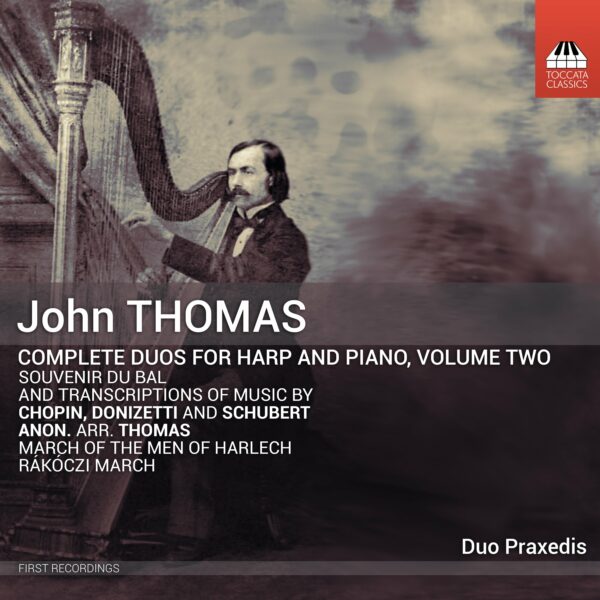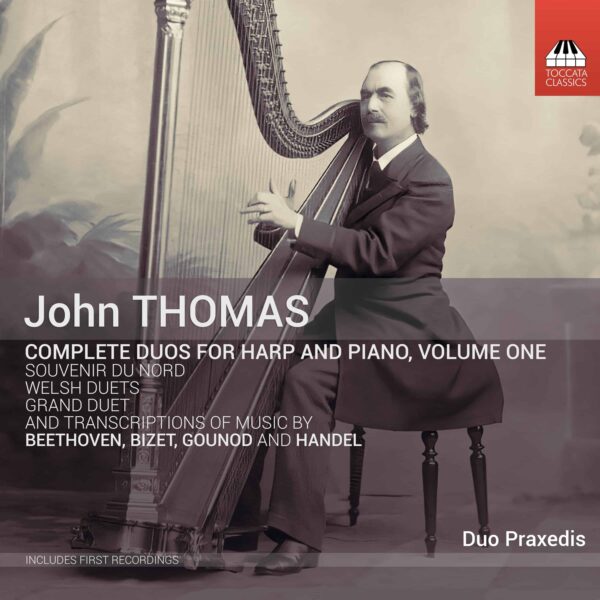John Thomas: Complete Duos for Harp and Piano, Volume Two
Harpist to Queen Victoria, the Welsh composer John Thomas (1826–1913) wrote prolifically for his own instrument, both for solo harp and for duos of two harps or harp and piano – a combination where the different sounds of the two instruments enhance the clarity of the texture. Thomas’ own compositions use the elegant Romantic style of his own day, but he also left a generous legacy of transcriptions, with no fewer than fourteen Schubert songs recorded on this second volume of his complete duos for harp and piano. Although some of his music was intended for the Victorian drawing room, other pieces require a virtuoso technique – and all of it has a thoroughly engaging melodic appeal.
Duo Praxedis
Praxedis Hug-Rütti, harp
Praxedis Geneviève Hug, piano
Listen To This Recording:
- March of the Men of Harlech
- Souvenir du bal
- Piano Sonata No. 2, Op. 35: Marche funèbre
- Ave Maria
- The Erl King
- Dein ist mein Herz
- Sérénade
- Marguerite
- The Wanderer
- The Fisher-maiden
- Barcarole
- L’Adieu (misattributed, composed by August Heinrich von Weyrauch)
- L’Éloge des Larmes
- To Sylvia
- Sois toujours mes seuls amours
- The Trout
- The Fountain
- Rákóczi-induló
- Duet on Themes from Lucia di Lammermoor
ANONYMOUS/THOMAS
JOHN THOMAS
FRYDERYK CHOPIN
FRANZ SCHUBERT
Complete Song Transcriptions
ANONYMOUS
JOHN THOMAS
FIRST RECORDINGS


Feuillonscout :
‘John Thomas “Complete Duos for Harp and Piano Vol.2”,markieren in diesem Kontext ein beeindruckendes Talent, eine stilistische Vielseitigkeit gepaart mit unersättlicher Neugier, sich prominente Werke seiner Zeitgenossen einzuverleiben und sie für sein Instrument und dessen Kombination mit de Klavier passend zu machen. […] Das Duo Praxedis arbeitet auf jeden Fall sein Markenzeichen überzeugend heraus: Nämlich ein souveränes Stilgefühl, mit dem er – in zahllosen Varianten – einen eleganten romantischen Stil auf die Gegebenheiten der Harfe übertragen hat. Das Lied von der Forelle wirkt schon fast so, als wäre es für das Duo Praxedis geschrieben worden, welches sich ja so sehr auf anmutiges, dabei verblüffend vielgestaltiges Spiel versteht. […] Gerade im Programm dieser CD fasziniert es, wie die Rollenverteilung zwischen „singender“ Melodiestimme und klangmalerisch feinzeichnenden Begleitfiguren beständig wechselt – das Wasser des imaginären Baches in diesem Lied scheint durch die Harfentöne erst richtig ins Funkeln zu geraten. […]
Hinzu kommen die ebenfalls hörenswerten, kultivierten Eigenkompositionen von John Thomas selbst. Dass sich all dies zu einem unerschöpflich erzählenden, aber niemals geschwätzigen Fluss vereint, ist beim Duo Praxedis, garantiert, denn auf Praxedis Hug-Ruetti und Genevieve Hug ist nun einmal immer Verlass. Und das macht natürlich jetzt neugierig, auch in die anderen Volumes hinein zu hören, mittlerweile ist die Serie bei ihrer fünften Nummer angekommen.’
English translation:
‘In this context, John Thomas’s “Complete Duos for Harp and Piano Vol. 2” demonstrates an impressive talent, a stylistic versatility paired with an insatiable curiosity to absorb prominent works by his contemporaries and adapt them to his instrument and its combination with the piano. […] The Duo Praxedis certainly convincingly develops its trademark: a sovereign sense of style with which it has – in countless variations – transferred an elegant romantic style to the realities of the harp. The Song of the Trout almost seems as if it had been written for the Duo Praxedis, which is so adept at graceful, yet astonishingly diverse playing. […] Particularly in the program of this CD, it is fascinating how the roles constantly shift between the “singing” melody and the sound-painterly detailed accompanying figures – the water of the imaginary stream in this song seems to truly sparkle with the harp tones. […]
Added to this are the equally worthwhile, sophisticated original compositions by John Thomas himself. The fact that all this combines into an inexhaustibly narrative, yet never garrulous, flow is guaranteed by the Praxedis duo, because you can always rely on Praxedis Hug-Ruetti and Genevieve Hug. And that, of course, makes us curious to listen to the other volumes as well; the series has now reached its fifth volume.’
—Feuillonscout März 2024
Klassik Heute :
‘ Künstlerische Qualität: 9
Klangqualität::9
Gesamteindruck:9 […]
Herzstück der Arrangements sind die dreizehn Schubert-Lieder. Sie sind raffiniert arrangiert, weil Klavier und Harfe sich immer wieder als Melodieführer abwechseln. Ob Drama (Erlkönig), Gebet (Ave Maria) oder Gesang: Thomas‘ Arrangements treffen den Schubert-Ton immer gut. Man taucht gerne ein in diese Misch-Klangwelt aus gehämmerten und gezupften Saiten – schließlich ist auch ein Klavier weitgehend Saiten-Instrument…Vielleicht speist sich dieser Mischklang aus dem Verwandtschaftsverhältnis der Musikerinnen, jedenfalls mischen sich die Instrumente nicht nur, sie ergänzen und befeuern sich gegensaitig und gegenseitig so intensiv, dass man manchmal, vor allem bei den runden tiefen Tönen des Klaviers, zweimal hinhören muss, um herauszubekommen, ob es Klavier- oder Harfentöne sind: Die beiden Musikerinnen bringen es fertig, Klavier- und Harfentöne einander anzugleichen.’
English translation:
‘Artistic quality: 9
Sound quality: 9
Overall impression: 9 […]
The heart of the arrangements are the thirteen Schubert songs. They are cleverly arranged, with piano and harp repeatedly alternating as melodic leaders. Whether drama (Erlkönig), prayer (Ave Maria), or song, Thomas’ arrangements always capture Schubert’s tone well. One enjoys immersing oneself in this mixed world of sounds made up of hammered and plucked strings – after all, a piano is also largely a stringed instrument…Perhaps this mixed sound is fed by the relationship between the musicians; in any case, the instruments don’t just blend; they complement and fuel each other with opposing strings and so intensely that sometimes, especially with the round, low notes of the piano, one has to listen twice to figure out whether they are piano or harp tones: the two musicians manage to harmonize the piano and harp tones.’
—Rainer W. Janka, Klassik Heute
Fanfare :
‘These arrangements are highly inventive, using the resources of the harp to flesh out the textures. The piano is a full partner, often taking over the melodic duties to produce a greater variety of tone color. […]
The Duo Praxedis, comprised of harpist Praxedis Hug-Rütti and pianist Praxedis Geneviève Hug, plays beautifully throughout, making the best possible case for Thomas. Cornelis Witthoefft’s scholarly 34-page essay, full of biographical, historical, and musical information, is itself worth the price of the disc. Recommended for harp fanciers and for anyone interested in the byways of 19th-century music.’
—Michael Vaillancourt, Fanfare
The Classical Music Guide Forums :
‘These recordings provide great listening experiences and provide immediate pleasure.’
—Lance G. Hill, The Classical Music Guide Forums